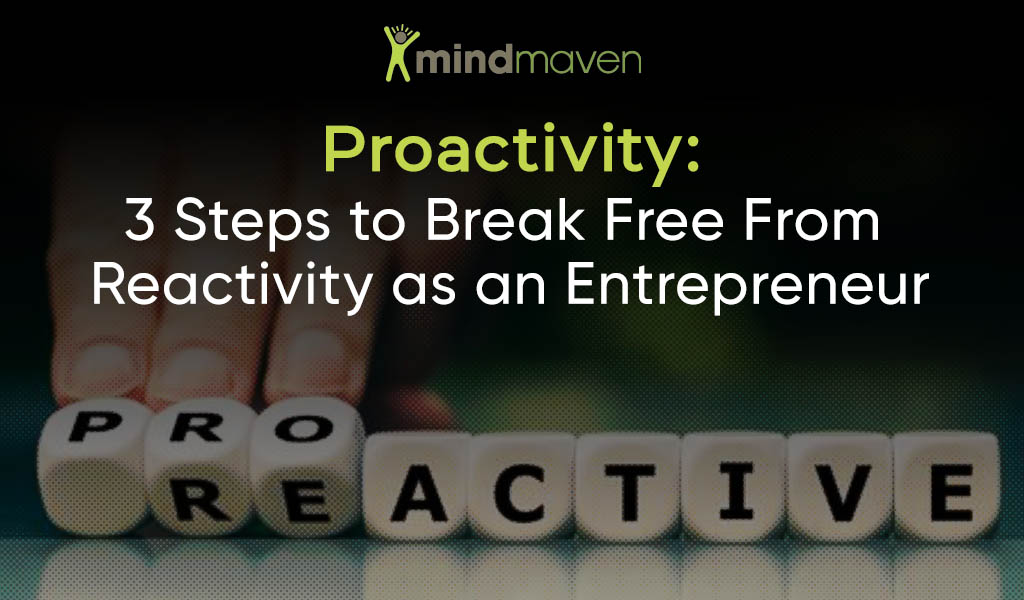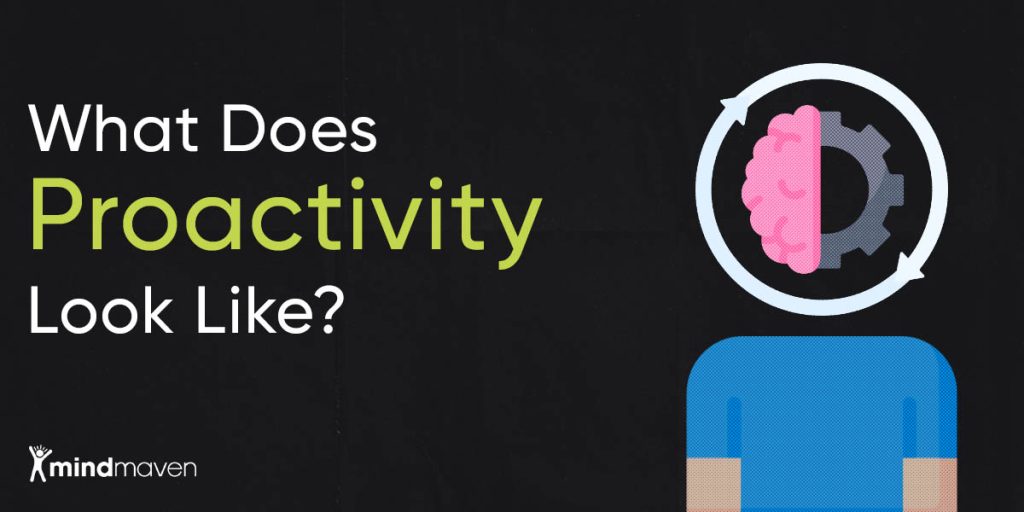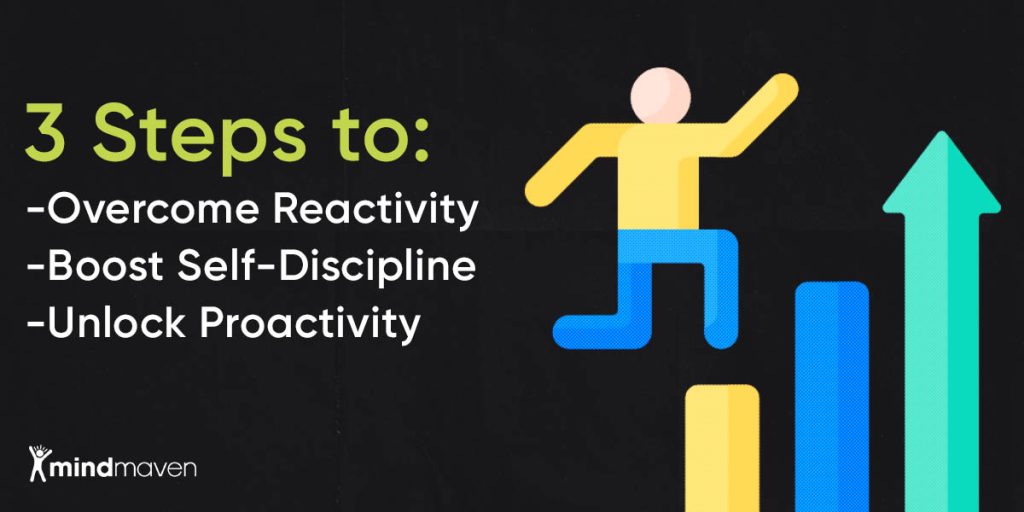
Proactivity is more than just a buzzword. Proactivity is a vital part of creating massive success, and it’s the only way to reach your full potential.
If you remain stuck in reactivity, the consequences are inevitable: wasted time, missed opportunities, and growing stress.
But by becoming proactive, you don’t just stay ahead of challenges—you actively create opportunities for growth.
In this article, we show you how to break free from reactivity as an entrepreneur, offering three actionable steps to reclaim your time and focus on high-impact work that truly moves the needle.
What Is Proactivity? And Why It’s Critical to Success
Proactivity is more than just staying busy—it’s about acting with intention.
According to Merriam-Webster, being proactive means “acting in anticipation of future problems, needs, or changes.”
When scaling a business, this translates to prioritizing tasks that drive long-term success rather than reacting to every immediate demand.
It means focusing on what’s important, not just what’s urgent.
Identifying the Reactivity Trap
The problem is, our world is becoming increasingly reactive, not proactive. According to Merriam-Webster, a reactive person is someone who is “readily responsive to a stimulus.”
In other words, a reactive person is at the mercy of urgency and outside influence.
The feeling of urgency often trumps the feeling of importance, causing many of us to spend our days stuck in an endless loop of:
- New email? Better respond right away.
- Meeting request? Can’t say no to that.
- Slack notification? Better respond before it’s lost in the endless stream of messages.
Then, at the end of the day, we wonder where our time went.
What makes reactivity so dangerous is that it feels productive.
After all, you just responded to 53 emails, right? Sure, but there’s a world of difference between “getting stuff done” and actually making progress.
Think of it this way: A proactive person is like a stallion, and a reactive person is like a rocking horse. Both are moving, but only one is moving forward.
Proactivity always outperforms reactivity. It wins the race every time.
What Does Proactivity Look Like?

Alright, we know what proactivity is, but what does it look like in action?
Reactive tasks are easy to identify—they’re the urgent, day-to-day time sinks most people do out of habit.
It’s not that reactive tasks don’t need to be done; it’s that they don’t have to be done immediately, and in most cases they don’t need to be done by you at all.
Identifying Proactive Tasks
Proactive tasks, on the other hand, require deeper thought, strategic thinking, and deliberate execution.
They’re the projects that move the needle most for your business – the great ideas that often get pushed aside because they don’t scream for your attention in the same way urgent tasks do.
Some examples of proactive tasks include:
- Developing strategic goals to ensure the upcoming year is both successful and aligned with your long-term vision,
- Advocate for a key product feature by outlining compelling reasons why it’s essential to the company’s growth, helping steer the business in the right direction, or
- Creating thought leadership content to establish yourself and your company as experts in your market.
In short: Proactivity means prioritizing the strategic initiatives that propel your business forward and help you turn your goals into reality.
They may not seem urgent, but they are crucial in creating sustainable success.
If you want to learn more about how you can proactively reach your goals, check out our article: A Success Guide to Scaling Yourself (While Scaling Your Business).
Embracing Proactivity: The Most Important Trait of Proactive People
So, what does it take to be proactive? In a word, discipline.
Emergencies will always arise, demands will increase, and you’ll be tempted to fall back into unproductive, reactive behaviors.
The moment you start incorporating proactivity into your life, the world will test your resolve.
To stay proactive in a reactive world, you need unyielding self-discipline.
Remember: You can’t always control your circumstances, but you can control your response.
You can choose to remain proactive.
Because in the end, success isn’t the result of circumstance; it’s the result of response to circumstance. And that’s the heart of self-discipline.
3 Steps to Overcome Reactivity, Boost Self-Discipline, and Unlock Proactivity

If you’re ready to stop spinning your wheels and start making meaningful progress, it’s time to embrace a proactive mindset.
These three actionable steps will help you sharpen your self-discipline, break the cycle of reactivity, and unlock the full power of proactivity in your daily life.
1. Create a Compelling Reason to Stay Disciplined
When reactive temptations arise, you’ll need a reason to remain disciplined. You could try to white-knuckle it, but you can only do that for so long before you wear out your resolve.
You’re much more likely to stay disciplined if you have a compelling reason to do so—a clear and motivating picture of what you’re working towards.
That’s where goals come in.
Studies have shown that “… individuals with clear, written goals are significantly more likely to succeed than those without clearly defined goals.”
Think of it this way: If you wanted to travel somewhere new, what’s the first thing you’d do?
Probably find it on a map. Then, once you knew where you were heading, you’d develop a plan to get there. And only once you’d done that would you actually start traveling.
In the face of distraction and temptation, goals are a vital tool to stay proactive, disciplined, and on track to success.
For more on effective goal creation, check out Your Ultimate Guide to Goal Setting: North Star Objectives.
Free Up Massive Time Every Week With an Executive Assistant
Often, eliminating procrastination requires more than self-discipline. You simply need more time.
One of the best ways to do this is by working with an Executive Assistant (EA).
Here at Mindmaven, we have revolutionized the role of the EA into an Engagement Manager (EM).
An EM can be likened to a hybrid between a skilled virtual Executive Assistant and a Chief of Staff, whose primary responsibility is empowering you to reach your fullest potential as a leader.
With our proven framework, an EM can help you free up 12+ hours every week by taking care of the repetitive, time-consuming tasks that pull you away from high-value work.
If you’re ready to learn how to reclaim your time while maximizing your throughput, check out our Amazon bestseller book, Radical Delegation.
Get your copy to transform how you work with an assistant and build the right workflows that make achieving your goals easy.
2. Free Up Time By Creating Whitespace
Procrastination isn’t always born from a lack of discipline—it’s more often the result of a lack of time.
When you’re stuck in a reactive cycle, responding to whatever’s most urgent, you’re not shaping the future—you’re just staying afloat.
You don’t intend to put things off, but you’re constantly caught in a back-to-back schedule, swamped with meetings, and bombarded by requests.
You tell yourself, “I’ll follow up later” or “I’ll get to that email when I have time,” but later rarely comes, and days pass. By the time you remember, it’s too late, and the opportunity feels lost.
The follow-up emails that strengthen relationships, the strategic thinking that sets the course, the deep work that moves the needle … all of it falls victim to procrastination simply because there’s always something more urgent.
This isn’t a failure of willpower; it’s a problem of bandwidth.
The key to overcoming this is not just better time management but creating “whitespace” in your schedule.
Incorporating Proactivity Into Your Life – Free Whitespace Time Guide
Whitespace Time is a crucial concept in proactive time management. It’s intentional, unstructured time deliberately carved out of your schedule to focus on high-value, strategic work.
To incorporate proactivity into your daily life, get free instant access to Whitespace Time: Your Guide To Proactive Time Management.
This guide will help you disconnect from reactive tasks (like emails, meetings, and notifications) and create (and protect) space in your schedule for deep thinking, planning, or creative problem-solving—the very things that drive growth and innovation.
Whether you want to strengthen your relationships, plan next year’s marketing strategy, or make room in your busy schedule for some much-needed mindfulness.
Whitespace Time is the practice that will help you regain control of your priorities.
3. Master the Art of Saying “No” Effectively – Without Damaging Your Relationships
One of the most powerful tools in your proactivity arsenal is the ability to say “no” effectively.
Every day, there are near-endless demands on your time—from meetings and calls to emails and quick favors. Someone always needs a “quick” 15 minutes from you.
While many of these might seem important, they often aren’t aligned with your long-term goals.
Learning to say “no” isn’t about being dismissive; it’s about protecting your time and energy so you can focus on what matters most.
Next time you get a request for your time, ask yourself: “Is this aligned with what I’ve decided to proactively work on this week?” If the answer’s no, your response should probably be no.
Setting Clear Boundaries Around Your Time
One of the most effective ways to do this is by setting clear boundaries. When a request comes in that doesn’t align with your proactive priorities, don’t hesitate to decline—politely but firmly.
Here’s how it works …
Instead of saying, “I can’t …” or “I won’t …” which are perceived as negative and personal, try rephrasing your response to set a general precedent.
With this approach, you’re not rejecting the person but instead setting clear boundaries around your time. For example:
- I don’t respond to emails after 8:00 pm,
- I don’t meet outside of the office, or
- I don’t reply to Slack messages over the weekend.
An added bonus: When you make an “I don’t” statement, you set a rule. As people become familiar with that rule, you’ll face fewer similar demands in the future.
Recap: Reclaim Your Time as a Proactive Leader
Breaking free from the reactive loop isn’t just about having better time management. It also requires you to lead with clarity, discipline, and intention. Here’s a quick recap of how to shift from reactive to proactive:
-
Define a compelling reason to stay disciplined. Break your big-picture goals into weekly priorities that keep you focused and motivated—even when distractions strike.
-
Create whitespace on your calendar. Block out deep, uninterrupted time each week to focus on strategic, needle-moving work.
-
Master the art of saying “no.” Set clear boundaries that protect your time without damaging relationships—so you stay aligned with your highest priorities.
Remember: when you proactively manage your time, you create the space to lead at your highest level.
Frequently Asked Questions
1. What’s the biggest barrier to being more proactive as a leader?
The most common barrier is a packed, reactive schedule. When your calendar is filled with back-to-back meetings and constant context-switching, there’s no space left for strategic, forward-thinking work. That’s why creating protected “whitespace” time each week is so important.
2. What is Whitespace Time?
Whitespace Time is dedicated, distraction-free time blocked on your calendar to focus on high-impact, strategic work—like deep thinking, planning, or building key relationships. It’s your chance to step out of reactivity and into the kind of work that truly drives long-term success.
At Mindmaven, we recommend leaders schedule weekly Whitespace sessions (e.g., 3-4 hours calendar blocks), giving them the clarity to lead with greater intention, which is essential for scaling impact.
3. I struggle to say “no” without damaging relationships. How can I set better boundaries?
It’s not about being dismissive. Learning how to say “no” is essential for being intentional as a leader. Mindmaven recommends framing boundaries using “I don’t” language instead of “I can’t,” which creates values-based guardrails around your time. For example: “I don’t schedule meetings before 10am so I can focus on strategic work.”
4. Can proactivity be trained or is it just a personality trait?
It can absolutely be trained. Proactivity is a discipline, not a personality type. Mindmaven’s executive coaching helps leaders build proactive habits and workflows that turn intention into repeatable systems, which reduce friction and improve long-term effectiveness.
5. How does Mindmaven help with becoming a more proactive leader?
We help executives change the way they operate—freeing up hours each week to focus on high-leverage work and implementing repeatable systems to improve time management, communication, and relationship-building. This creates more space for clarity, impact, and sustainable growth.
Take the First Step Toward Proactive Leadership – Request a Call
Being proactive means investing in your future.
Ask yourself: Are you 100% happy with the present? Have you completed all you set out to do? Is your bucket list empty? Or do you feel there’s still more success to be experienced?
No matter how good things are now, there’s always the potential for something even greater. And that future can be yours if you’re willing to invest in it.
At Mindmaven, we’ve spent over 15 years coaching leaders across industries—from top-tier venture capital firms to unicorn startups—to break free from the reactive cycle and unlock their full potential.
Here are what just a few of the business leaders we’ve worked with have to say about Mindmaven executive coaching:
“Thanks to tactics like voice dictations, meeting debriefs, and inbox shadowing, I’ve freed up at least 10 hours in my week.” — Noah Glass, Founder and CEO, Olo
“I thought I was proactive and very productive before, but Mindmaven helped me raise my game to a whole new level. It’s incredibly liberating to start every day knowing exactly what I need to focus on, rather than allowing my inbox to draw too much attention.” — Scott Mordell, Former CEO, YPO
“Mindmaven brought me more predictable days, less stress, and stronger relationships. The depth they operate at when teaching how to connect more deeply with others is simply profound.” — Steve Huffman, Co-Founder and CEO, Reddit
If you’re ready to reclaim your time, transform your workflows, and achieve Superpowered results faster than ever, let’s talk.
We invite you to schedule a free 1:1 consultation with one of our expert coaches.
During this call, we’ll identify your specific challenges and explore potential solutions to help you lead with intention, maximize your impact, and create space for what matters most.
Ready to elevate your leadership and live a more fulfilling life?


